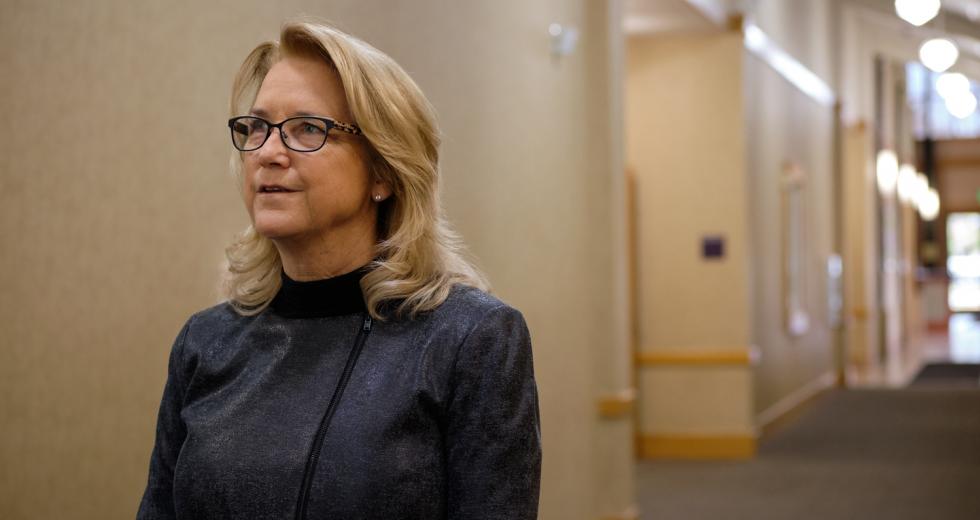To understand how California’s corporate boards have changed, one local research project is both a yardstick and a symbol. In 2005, UC Davis Graduate School of Management researchers began looking at the participation of women in corporate leadership at the largest publicly traded companies headquartered in the state.
The first year that the study included a comparable number of companies across years was 2006. That year, women held fewer than 9 percent of board seats at the 400 companies assessed. By 2015, that had grown to more than 13 percent. Were that rate to hold, women would reach parity on those boards in 2099.
But the school won’t be tracking that evolution if it happens: 2015 would be the last year of the project. Over the years, no donor had stepped forward to cover the $15,000 cost. The faculty who strongly supported it had moved on, and school leaders were concerned that the results weren’t peer reviewed. But there was another reason, says Donald Palmer, a GSM professor who managed the project until 2013: “Year in and year out, the results looked pretty much the same,” he says. “At some point, it ceased to be news.”
Senate Bill 826, passed easily by the state Legislature in August 2018, aims to change that. By January 2020, publicly traded companies headquartered in California must have a minimum of one woman on their boards of directors and two or three by January 2022, depending on board size. The penalties for not complying are serious: $100,000 on the first offense and $300,000 for the second and subsequent violations.
The law drew national attention, praised by advocates of gender diversity in corporate leadership. Of the 621 state-headquartered companies that are also traded on major stock exchanges, 29 percent have all-male boards, according to research from San Diego’s Board Governance Research. That pencils out to 1,060 seats that need to be filled by women by 2022. However, a potential legal challenge to the law could drop that number to at most 208, according to research from Stanford University’s Rock Center for Corporate Governance. Regardless of the numbers, getting into position to be invited onto a corporate board is a steep road for any executive. So how do qualified women rise to the top? It won’t be easy.
Why Board Seats Are Hard to Land
In 2009, Kim Box left Hewlett-Packard, where she’d spent 29 years leading technology teams — her last role was vice president of global IT services. (She’s currently president and CEO of Gatekeeper Innovation, where she’s been since 2016.) As she neared the end of her time at HP, she started planning her next move. She’d served on nonprofit boards and thought joining a corporate board would be a logical way to contribute her leadership skills in another enterprise. Unsure of how to get into a position for a directorship, she started contacting people in her network to find out what it would take.
She belonged to the American Leadership Forum, and at an ALF breakfast in late 2011, she mentioned her interest in a corporate board. Another member was a director at American River Bank and served on the board’s nominating committee. She sent him her bio, and by mid-2012 she was invited to join and has spent the last seven years there. That also made her attractive to the board of Livermore-based McGrath RentCorp, which she joined last year.
Box says her story offers no easy lessons. “Everyone wants a five-step process [for a board seat],” she says. “There aren’t a lot of board positions, so it’s not easy for anyone, including men, to get on them,” she says.
Related: Will SB 826 Survive?
Related: Got questions on how to join a corporate board? Ask them here.
That points to a structural reason for the glacial speed of change in board diversity, beyond potential gender bias: They don’t turn over much. A report two years ago found the average age for S&P 500 company directors was 62. The average tenure stands at nine years among S&P 1500 firms — a lethargic pace that worries institutional investors, according to a 2016-17 survey by Institutional Shareholder Services.
When there is an opening, only a small group of executives possess the chops that attract attention, experts say. To even be considered, candidates need to either have the right expertise, or in some companies, own a significant number of shares. Expertise normally means C-suite experience at the top of a publicly traded company. And the strongest candidates have a background in the company’s industry, and experience operating in a similar stage of the business life cycle and with a similar business model. “You can’t just take a class; you have to have the skills,” Box says. Her IT background made her particularly attractive as a “digital director,” offering guidance on a firm’s digital strategies, for both boards on which she serves.
Companies pay attention to whom they include on boards because directors impact profits. A 2016 survey of the academic literature concluded that several board characteristics, including a board’s strength of oversight, independence and diversity correlate with higher corporate performance. That last item has gotten more attention in recent years, with a flood of studies connecting diversity in corporate leadership to better company outcomes. The last UC Davis study, for example, concluded that the top 25 most gender-diverse companies based in California showed average returns on assets and equity 74 percent higher than for the entire sample.
Those results reflect mere correlations between diversity and performance — causal links require further scrutiny. But Roger Akers of Fair Oaks-based venture capital firm Akers Capital cites that research and says he’s seen why those results happen. On the 20-plus boards he’s served on, he says, “In general, women have greater attention to detail and try harder, and I’ve seen that myself.”
So how do female executives who fit the bill find the right company and get themselves in position for a board seat?
The Rigorous How-To Guide
There are no quick fixes, and preparing for a board of directors is a career-long process, according to the experts.
Diane Miller is president and CEO for Sacramento-based executive search firm Wilcox Miller & Nelson. A corporate governance expert, she also serves on the board of Career Partners International and spent nine years as a director at Umpqua Bank.
Miller says a candidate’s resume must “read well on the street.” That means an MBA or a degree specifically related to the company’s industry is essential, as is a demonstrated passion for the firm and its mission. Executive experience arms strong candidates with financial expertise, an understanding of revenue streams and market segmentation, and the ability to evaluate talent.
Directors also must be financially independent of their board position and have the time to commit — Miller estimates 240-400 hours per year. “It’s really a second job,” she says.
Those tough preconditions mean presentation matters. One of Box’s early steps was to talk to an executive recruiter who specialized in directors. The recruiter told Box that her marketing materials had to change — her three- to four-page CV wouldn’t do for a board-nominating committee. Instead, Box used her advice to create a “board-ready” bio: a single-page narrative, written in the third person, that summarized her board-relevant executive experience, the nonprofit boards she served on and her other community involvements. She did something similar on her LinkedIn page, cutting the length and collapsing her chronologically listed executive roles into a narrative about what she’s done as a leader.
Still, don’t count on a recruiter walking you in the front door. Box says that though that connection helped her better market herself, board openings aren’t posted, so candidates are most often selected on the basis of connections rather than through recruiters. (The group that actually does the selecting typically is the nominating or governance committee, with shareholders voting on their recommendations.)
Area experts all mention strategic networking as essential to getting into position, since many board directors are chosen through elite social networks. “People on boards want others who they’ve worked with,” says Julie Reinganum, who coaches CEOs at Vistage International and has served on the boards of Hong Kong-based Javelin Investments and Texas-based The Bombay Company. Her connections were what got her invited to serve at the latter firm. The company was looking to expand internationally, and her contact on the inside recommended Reinganum on the grounds that she’d just sold her China-focused management consulting firm.
Akers recommends volunteering with the Sacramento chapter of the National Association of Corporate Directors, which is being reconstituted, with the help of NACD’s San Francisco chapter, after a period of relative dormancy. He says corporate advisory boards — which provide nonbinding advice to company leaders — also provide a good training ground, while nonprofit board service can facilitate the networking needed for a corporate director position in the future. But he cautions that nonprofit board service “isn’t as relevant to the technical skills — like understanding industry-specific market segmentation, governance and organizational development — that will matter in getting onto a corporate board.”
And certain skills are in higher demand than others. Boards reliably need CPAs and attorneys, but Akers says that expertise in advertising and marketing are in particular demand now. And Miller says that half of searches for board candidates she’s seeing call for someone with a technical background.
Some industries have more gender-diverse boards than others — Reinganum points to retail as one. Currently, and perhaps counterintuitively, more-established firms boast more gender-diverse boards: One analysis last year of data on public companies found that firms that had recently held an initial public offering picked women for only 10 percent of their board seats — compared with 34 percent for the rest of the sample.
Education and training also help, though there’s a big caveat. With SB 826 in place, it’s easy to be lured by the idea that continuing education and workshops will put you in position for a seat. But “the list [of qualifications] has to be checked,” Miller says. “I’d warn anyone away from someone who says, ‘I’ll help you get a board seat.’” Still, there are recognized, credentialed programs at established schools that offer education on the roles and responsibilities of directors, she says — like the Stanford Law School Directors’ College for current executives and directors.
Some SB 826 supporters would like to see the state step in with resources to help companies comply. Lori Kammerer runs her own consultancy focused on government relations and advocacy, and serves as vice president of public policy for the Sacramento Valley chapter of the National Association of Women Business Owners (which sponsored the bill). She suggests the secretary of state’s office set up a website that lists C-suite-level women in different industry sectors who are qualified board candidates. That would make it easier for companies to match candidates with board openings and help them meet the mandates, she says.
“The purpose of this bill isn’t to add a token woman — you want to bring on a woman who’s going to be the best match,” she says. “You want to know [as a company], ‘Are there a dozen, two dozen, a hundred women who could fill this role?’ We’re very confident that they’re out there.”
Got questions on how to serve on a corporate board? Ask them here.
Listen Now: Action Items Minisodes: Gender Diversity and Boards of Directors
Editors Note: This story has been edited to reflect that Kim Box was with HP for 29 years, not 19 as originally reported. We regret the error.
Recommended For You

Will SB 826 Survive?
Last August’s law, SB 826, was in part the product of frustration. In 2013, one of its sponsors, Sen. Hannah-Beth Jackson, authored a resolution that urged all publicly held California corporations to ensure one-fifth of their board directors were women by the end of 2016. While adopted by both legislative chambers, the resolution carried no consequences. When the deadline rolled around, fewer than 20 percent of companies had actually hit the target, according to a Senate analysis.

The Voice of Capital Region Chambers Is Decidedly Female — Here’s What They Have to Say
There are roughly 50 chambers in the Capital Region, and we counted over 30 led by women. We asked a dozen of these leaders (doing our best to bring in a mix of voices) to tell us where they see the region headed.

Action Items Minisodes: Gender Diversity and Boards of Directors
Senate Bill 826, passed easily by the state Legislature in August 2018, requires publicly traded companies headquartered in California to have a minimum of one woman on their boards of directors by January 2020 — and two or three by January 2022, depending on board size.

2020 Women on Boards/Sacramento Campaign Committee
2018 National Conversation on Board Diversity – Sacramento
The 2020 Women on Boards/Sacramento Campaign Committee held the 2018 National Conversation on Board Diversity – Sacramento on Nov. 15 at the Sutter Club downtown. The keynote luncheon panel was introduced by Comstock’s Editor in Chief Allison Joy and Clayton Blakley, VP/business development. 2020 Women on Boards is a national campaign to increase the percentage of women on U.S. company boards to 20 percent or greater by the year 2020.



